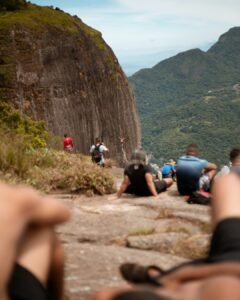Comprehensive Guide of Cycling
Overview
Cycling is a popular and versatile hobby that involves riding a bicycle for recreation, fitness, or transportation. It offers numerous physical and mental health benefits, including improved cardiovascular fitness, muscle strength, and mental well-being. Cycling can be enjoyed on various terrains, from smooth city streets to rugged mountain trails, making it accessible to a wide range of enthusiasts. Whether it’s leisurely rides through scenic landscapes, competitive racing, or commuting to work, cycling provides an exhilarating way to explore the outdoors and stay active. Additionally, it fosters a sense of community among cyclists, with many joining clubs or participating in group rides and events.
History
The history of cycling dates back to the early 19th century with the invention of the first bicycle, known as the ‘Dandy Horse’ or ‘Laufmaschine,’ created by Baron Karl von Drais in 1817. This early model was propelled by the rider’s feet pushing against the ground. The introduction of pedals in the 1860s led to the development of the penny-farthing, which featured a large front wheel and a smaller rear wheel. The safety bicycle, which resembles modern bicycles, emerged in the 1880s, making cycling more accessible and safer for the general public. Over the years, cycling has evolved with advancements in technology, materials, and design, leading to the creation of specialized bikes for various purposes, including road cycling, mountain biking, and touring.
Popularity and Demographics
Cycling has gained immense popularity worldwide, appealing to individuals of all ages and backgrounds. According to a report by the World Health Organization, cycling is one of the most popular forms of physical activity, with millions of people participating regularly. In urban areas, cycling is increasingly recognized as an eco-friendly mode of transportation, contributing to its growth among commuters. Demographically, cycling attracts a diverse audience, with many recreational cyclists being young adults and families, while competitive cycling draws athletes of all ages. The rise of cycling events, such as charity rides and races, has further fueled interest in the hobby, creating a vibrant community of cyclists who share a passion for the sport.
Sponsored Hobbyists and Vendors
Become a Sponsor!
Affiliate Disclaimer: Throughout some sections below, Hobby Spotlight may suggest some tools, equipment or material using affiliate links. By purchasing any of those items, Hobby Spotlight may earn a small commission. This helps fund our website, content and services without directly charging our users.
Getting Started
Essential Cycling Gear:
Beginner
- Basic Bicycle: A simple, entry-level bike suitable for casual riding.
- Helmet: A safety helmet to protect your head while cycling.
- Water Bottle: A reusable water bottle to stay hydrated during rides.
- Cycling Gloves: Padded gloves to enhance grip and comfort while riding.
- Bike Lock: A sturdy lock to secure your bike when not in use.
Intermediate
- Cycling Shoes: Specialized shoes designed for better power transfer and comfort.
- Bike Repair Kit: A kit containing essential tools for on-the-go repairs.
- Cycling Computer: A device that tracks speed, distance, and other metrics.
- Padded Bike Shorts: Comfortable shorts with padding for longer rides.
- Bike Pump: A pump to inflate tires and maintain optimal pressure.
Basic Requirements and Initial Setup:
- Bicycle: Choose a suitable bike type (road, mountain, hybrid) based on your riding style and terrain preferences. Ensure it fits your body size for comfort and efficiency.
- Safety Gear: Invest in a quality helmet, reflective clothing, and lights for visibility. Additional protective gear like gloves and knee pads can enhance safety.
- Maintenance Tools: Have basic tools on hand, such as a tire pump, multi-tool, and patch kit, to handle minor repairs and maintenance on the go.
Fundamental Skills to Learn:
- Bike Handling: Develop skills in steering, braking, and cornering to navigate various terrains safely.
- Gear Shifting: Learn how to effectively use gears to manage different inclines and speeds, optimizing your cycling experience.
- Route Planning: Understand how to plan routes that match your skill level and desired distance, considering traffic and road conditions.
- Basic Repairs: Familiarize yourself with fixing flat tires, adjusting brakes, and maintaining chain lubrication to keep your bike in top condition.
- Endurance Building: Gradually increase your riding distance and intensity to improve stamina and overall fitness.
Sub-Hobby/Common Activities:
- Mountain Biking: Riding on off-road trails, focusing on technical skills and navigating natural obstacles.
- Road Cycling: Long-distance riding on paved roads, often involving group rides and races.
- Commuting: Using a bicycle for daily transportation, promoting sustainability and fitness.
- Cycling Tours: Participating in organized tours that explore new areas, often combining cycling with sightseeing.
- Bike Maintenance Workshops: Attending classes to learn more about bike repair and maintenance techniques.
Terminology:
- Cadence: The rate at which a cyclist pedals, usually measured in revolutions per minute (RPM).
- Drafting: Riding closely behind another cyclist to reduce wind resistance and conserve energy.
- Gearing: The system of gears on a bicycle that allows the rider to adjust resistance and speed.
- Handlebar Height: The vertical position of the handlebars, which affects riding posture and comfort.
- Interval Training: A training method that alternates between high-intensity efforts and recovery periods to improve fitness.
- Peloton: A group of cyclists riding closely together to benefit from drafting.
- Recovery Ride: A low-intensity ride aimed at promoting recovery after more strenuous workouts.
- Stability: The ability of a bicycle to maintain balance while riding, influenced by design and rider technique.
- Torque: The rotational force applied to the pedals, affecting acceleration and climbing ability.
- Wheelbase: The distance between the front and rear axles of a bicycle, impacting stability and handling.
Advanced Topics and Specializations
Advanced Cycling Equipment:
- Carbon Fiber Road Bike Frame: A lightweight and durable frame designed for high performance and speed in competitive cycling.
- Smart Bike Trainer: An interactive trainer that connects to apps for virtual cycling experiences and performance tracking.
- High-Performance Cycling Shoes: Shoes designed for optimal power transfer and comfort, often featuring stiff soles and a snug fit.
- GPS Cycling Computer: A device that tracks speed, distance, elevation, and navigation, providing real-time data during rides.
- Hydration Pack with Bladder: A backpack designed for cyclists that includes a water reservoir and a tube for hands-free hydration on the go.
Advanced Projects and Achievements:
- Long-Distance Touring: Completing multi-day cycling tours that cover hundreds of miles, often involving overnight camping and navigating diverse terrains.
- Competitive Racing: Participating in local, national, or international cycling races, showcasing speed and endurance in various cycling disciplines.
- Custom Bike Builds: Designing and assembling personalized bicycles tailored to specific riding styles, preferences, and performance needs.
Advanced Techniques and Methods:
- Bike Maintenance and Repair: Mastering skills to perform advanced repairs, including wheel truing, brake adjustments, and drivetrain tuning.
- Climbing Techniques: Utilizing specific body positioning and gear selection to efficiently ascend steep hills and challenging terrains.
- Pacing Strategies: Developing personalized pacing plans for endurance rides and races to optimize performance and energy management.
Specializations and Niche Areas:
- Mountain Biking: Focusing on off-road cycling, navigating rugged trails, and mastering technical skills for downhill and cross-country riding.
- Road Cycling: Engaging in high-speed cycling on paved roads, often participating in group rides and competitive events.
- Commuter Cycling: Emphasizing practical cycling for daily transportation, including urban navigation and safety techniques.
- Cycle Touring: Exploring long-distance travel by bike, often incorporating camping and cultural experiences along the route.
- Electric Biking: Utilizing electric bicycles to enhance riding experience, focusing on battery management and maintenance.
Future Trends and Innovations:
- Increased adoption of electric bikes, making cycling accessible to a broader audience.
- Development of smart cycling gear, including wearable technology that tracks performance metrics in real-time.
- Growing emphasis on sustainable cycling practices, including eco-friendly bike materials and carbon offset programs.
- Integration of augmented reality in cycling apps for enhanced navigation and training experiences.
- Expansion of cycling infrastructure in urban areas, promoting safer and more accessible routes for cyclists.
Technology Integrations:
- GPS Navigation Devices: Using advanced GPS systems for route planning and tracking during rides.
- Fitness Tracking Apps: Leveraging mobile applications to monitor performance metrics such as speed, distance, and heart rate.
- Smart Helmets: Incorporating technology that provides navigation prompts and communication features while riding.
- Online Cycling Communities: Engaging with virtual platforms for sharing experiences, tips, and organizing group rides.
- Virtual Training Programs: Utilizing online platforms for structured training plans and interactive cycling simulations.
Further Learning and Resources
Books:
- The Complete Guide to Cycling by John Doe: An introductory book that covers the basics of cycling, including types of bikes, gear, and essential maintenance tips for new cyclists.
- Cycling for Fitness by Jane Smith: This book focuses on using cycling as a means to improve fitness, featuring beginner-friendly training plans and nutritional advice.
- Bicycling Magazine’s Complete Guide to Cycling by Various Authors: A comprehensive guide filled with tips, techniques, and insights from experienced cyclists, ideal for those just starting out.
- The Cyclist’s Training Bible by Joe Friel: An in-depth resource for serious cyclists, offering advanced training strategies, periodization, and performance-enhancing techniques.
Websites:
- BikeRadar, https://www.bikeradar.com – A comprehensive resource for cycling news, reviews, and advice on gear and maintenance.
- Cycling Weekly, https://www.cyclingweekly.com – Offers the latest cycling news, training tips, and product reviews for cyclists of all levels.
- Strava, https://www.strava.com – A social network for athletes that allows cyclists to track their rides, share routes, and connect with others.
- Adventure Cycling Association, https://www.adventurecycling.org – Focuses on bike touring and offers maps, resources, and a supportive community for long-distance cyclists.
- Global Cycling Network (GCN), https://www.globalcyclingnetwork.com – Provides cycling tips, tutorials, and entertaining videos for cyclists of all abilities.
Courses:
- Udemy Cycling Courses, https://www.udemy.com/courses/search/?q=cycling – A variety of courses covering cycling techniques, training plans, and bike maintenance for all skill levels.
- Coursera – The Science of Cycling, https://www.coursera.org/learn/science-of-cycling – An introductory course that explores the science behind cycling performance and training.
- Skillshare Cycling Classes, https://www.skillshare.com/browse/cycling – Offers project-based classes focusing on cycling skills, fitness, and bike maintenance.
- BikeFit – Professional Bike Fitting Course, https://www.bikefit.com – A specialized course for those interested in learning about bike fitting techniques to enhance comfort and performance.
- TrainingPeaks – Cycling Training Plans, https://www.trainingpeaks.com – Provides structured training plans and coaching for cyclists looking to improve their performance.
Content Creators and Community
Content Creators:
- Global Cycling Network (GCN) (YouTube): A leading channel for cycling enthusiasts, offering tips, reviews, and insights into cycling culture, gear, and training.
- BikeRadar (YouTube): Provides expert advice on bike maintenance, reviews of the latest gear, and cycling tips for all levels of riders.
- Chris King (Instagram): A professional cyclist sharing his experiences, training tips, and insights into the cycling lifestyle.
- Seth’s Bike Hacks (YouTube): Focuses on bike maintenance, DIY projects, and entertaining cycling content for enthusiasts.
- VeloFix (Instagram): A mobile bike repair service sharing tips, tricks, and cycling inspiration through engaging visuals.
- The Bike Show (YouTube): A podcast-style show discussing cycling news, interviews with cyclists, and various cycling-related topics.
- Ted King (Instagram): A former professional cyclist sharing his journey, cycling adventures, and insights into the cycling community.
Online Forums and Social Media Groups:
- Reddit – /r/Cycling: A vibrant community for cyclists to share experiences, ask questions, and discuss all things cycling.
- Facebook Cycling Groups: Various groups dedicated to different cycling interests, from road biking to mountain biking, where members share tips and experiences.
- CyclingTips Community (Discord): An interactive platform for live discussions, advice, and sharing cycling routes and experiences.
- Instagram Hashtags (#cycling, #bikelife): Follow trending cycling photos, tips, and community stories through popular hashtags.
- Pinterest Boards: Explore a variety of cycling-related content, including tips, gear recommendations, and cycling routes curated by enthusiasts.
Local Clubs and Organizations:
- Local Cycling Clubs: Many cities have cycling clubs that organize group rides, training sessions, and social events for cyclists of all levels.
- Cycling Advocacy Groups: Organizations that promote cycling safety, infrastructure improvements, and community engagement through cycling.
- Bike Co-ops: Community-run workshops where cyclists can learn maintenance skills and share resources.
- Charity Rides: Local events that combine cycling with fundraising for various causes, fostering community and camaraderie.
- Meetup Groups: Platforms like Meetup.com host local cycling events, group rides, and social gatherings for cyclists.
Events, Meetups, and Conventions:
- Sea Otter Classic: A premier cycling festival featuring races, demos, and a large expo showcasing the latest cycling gear and technology.
- Local Cycling Races: Various regional races and competitions that encourage participation and skill development among cyclists.
- Bike Festivals: Events that celebrate cycling culture with activities, workshops, and community rides.
- Cycling Workshops: Learn from experienced cyclists and mechanics at workshops focused on bike maintenance, safety, and riding techniques.
- National Bike Summit: An annual event that brings together advocates, policymakers, and cycling enthusiasts to discuss cycling issues and promote advocacy.
Associated Hobbies
- Mountain Biking: This thrilling form of cycling involves riding on off-road trails and rugged terrains. Mountain biking offers an adrenaline rush and a chance to explore nature while improving fitness and bike handling skills.
- Road Cycling: Focused on paved roads, road cycling is popular for long-distance rides and racing. Cyclists often join clubs or participate in events, enhancing their skills and enjoying the camaraderie of fellow riders.
- Bike Maintenance: Many cycling enthusiasts take up bike maintenance as a hobby. Learning to repair and maintain bikes not only saves money but also deepens the understanding of how bicycles work.
- Cycle Touring: This hobby combines cycling with travel, allowing enthusiasts to explore new places at their own pace. Cycle touring can range from weekend trips to long-distance adventures across countries.
- Commuting by Bike: Using a bicycle for daily commuting is an eco-friendly choice that promotes fitness. Many cyclists enjoy the challenge of navigating urban environments and discovering new routes.
- Participating in Cycling Events: From charity rides to competitive races, participating in cycling events can be a rewarding experience. These events often foster a sense of community and provide opportunities to meet fellow cyclists.
- Cycling Advocacy: Many cyclists become advocates for better cycling infrastructure and safety measures in their communities. This can involve participating in local organizations, attending meetings, and promoting cycling as a sustainable mode of transport.
- Photography and Blogging: Capturing cycling adventures through photography or blogging can be a fulfilling hobby. Many cyclists share their experiences, tips, and scenic routes, inspiring others to take up cycling.
Cost and Budgeting
Initial Investment and Ongoing Costs:
- Initial Investment: The cost to start cycling can vary significantly based on the type of bike and gear you choose. A basic entry-level bike can range from $300 to $600, while higher-end models, such as road or mountain bikes, can cost anywhere from $1,000 to over $5,000. Additionally, essential gear like a helmet, lights, and a lock can add another $100 to $300 to your initial investment.
- Ongoing Costs: Regular maintenance is crucial for cycling, which may include tire replacements, brake adjustments, and chain lubrication. Budget around $50 to $150 annually for basic maintenance. If you ride frequently, you may also need to replace tires every 1,000 to 2,000 miles, costing $30 to $100 per tire. Other ongoing costs can include clothing, accessories, and potential bike upgrades.
Budget-Friendly Options:
- Used Bikes: Consider purchasing a second-hand bike from local classifieds, bike shops, or online marketplaces like Craigslist or Facebook Marketplace. You can often find quality bikes at a fraction of the original price.
- Basic Gear: Start with essential gear only, such as a helmet and a basic repair kit. As you become more experienced, you can gradually invest in additional accessories like cycling shoes or specialized clothing.
- Community Programs: Look for local cycling clubs or community programs that offer bike-sharing or rental services, allowing you to enjoy cycling without the full investment of purchasing a bike.
Where to Buy:
- Local Bike Shops: These shops often provide personalized service, expert advice, and the opportunity to test ride bikes before purchasing.
- Sporting Goods Stores: Retailers like Dick’s Sporting Goods or REI offer a range of bikes and cycling gear, often with knowledgeable staff to assist you.
- Online Retailers: Websites like Amazon, Jenson USA, and Chain Reaction Cycles provide a wide selection of bikes and accessories, often at competitive prices, with the convenience of home delivery.
Money Making
How to Turn the Hobby into a Profession or Side Hustle:
- Cycling Tour Guide: Become a cycling tour guide by leading groups on scenic bike routes. You can specialize in local tours, adventure cycling, or even international cycling trips, sharing your knowledge of the area and ensuring a memorable experience for participants.
- Bicycle Repair and Maintenance Business: If you have mechanical skills, consider starting a bicycle repair shop. You can offer services such as tune-ups, flat tire repairs, and custom bike builds. This can be done from a physical location or as a mobile service, visiting clients at their homes or workplaces.
- Cycling Apparel and Gear Line: Use your understanding of cycling needs to design and sell your own line of cycling apparel and gear. Focus on creating high-quality, functional clothing and accessories that cater to cyclists, such as moisture-wicking jerseys, padded shorts, and durable bike bags.
- Cycling Content Creator: Share your cycling experiences and expertise through a blog, YouTube channel, or social media. You can create content around bike reviews, maintenance tips, and cycling routes. Monetize your platform through sponsorships, affiliate marketing, and merchandise sales.
- Cycling Coaching and Training Programs: If you have a background in fitness or competitive cycling, consider offering coaching services. You can create personalized training plans, conduct group rides, or provide nutrition advice to help cyclists improve their performance and reach their goals.
Benefits and Enjoyment
Physical, Mental, and Social Benefits:
- Physical Fitness: Cycling is an excellent cardiovascular workout that strengthens the heart, improves lung capacity, and enhances overall endurance. Regular cycling can help maintain a healthy weight, build muscle strength, and improve joint mobility.
- Mental Well-being: Engaging in cycling can significantly reduce stress and anxiety levels. The rhythmic motion and fresh air can boost mood and promote mental clarity, making it a great way to unwind and clear the mind.
- Social Interaction: Cycling can be a social activity, whether joining a local cycling group, participating in charity rides, or simply biking with friends and family. These interactions foster community, create friendships, and enhance the overall enjoyment of the hobby.
Success Stories and Inspirational Examples:
- Greg LeMond: A three-time Tour de France winner, Greg LeMond is a legendary figure in cycling. He overcame significant challenges, including a near-fatal hunting accident, to return to competitive cycling and inspire countless others to pursue their cycling dreams.
- Marianne Vos: Known as one of the greatest female cyclists, Marianne Vos has won multiple world championships and Olympic medals. Her dedication to the sport and advocacy for women’s cycling has inspired many young female athletes to take up cycling.
- James Golding: After battling cancer, James Golding took up cycling as part of his recovery. He has since completed numerous long-distance cycling challenges, raising awareness and funds for cancer research, proving that cycling can be a powerful tool for personal transformation and advocacy.
Ways to Enjoy and Grow in the Hobby:
- Explore New Routes: Challenge yourself by discovering new cycling trails or routes in your area. This not only keeps the hobby fresh but also allows you to experience different landscapes and environments.
- Participate in Events: Join local cycling events, races, or charity rides. These events can provide motivation, a sense of community, and opportunities to meet fellow cycling enthusiasts.
- Invest in Quality Gear: Upgrading your bike or investing in quality cycling gear can enhance your experience. Consider getting a bike fit to ensure comfort and efficiency, which can lead to improved performance and enjoyment.
Challenges and Solutions
Common Challenges Faced by Hobbyists:
- Cost of Equipment: Cycling can require a significant investment in gear, including a quality bike, safety equipment, and maintenance tools. This can be a barrier for many who want to start or continue the hobby.
- Physical Strain: Cycling can be physically demanding, especially for beginners or those with pre-existing health conditions. Muscle soreness, fatigue, and injuries can deter individuals from enjoying their rides.
- Weather Conditions: Inclement weather can limit cycling opportunities. Rain, snow, or extreme heat can make it uncomfortable or unsafe to ride, leading to frustration for enthusiasts.
- Finding Safe Routes: Not all areas have safe cycling paths or lanes, which can make it challenging to find suitable places to ride. This can discourage cyclists from exploring new routes or enjoying longer rides.
Tips for Overcoming These Challenges:
- Budget Wisely: Look for budget-friendly options when purchasing equipment. Consider buying used bikes or gear, and prioritize essential items to minimize costs.
- Build Up Gradually: Start with shorter rides and gradually increase distance and intensity to build endurance and strength. This approach can help prevent injuries and make cycling more enjoyable.
- Check the Weather: Always check the weather forecast before heading out. Plan rides for times when conditions are favorable, and consider indoor cycling options during bad weather.
- Research Routes: Use cycling apps or local cycling groups to find safe and enjoyable routes. Many communities have dedicated cycling paths that can enhance your riding experience.
Safety Considerations and Best Practices:
- Always wear a properly fitted helmet to protect your head in case of an accident.
- Use lights and reflective gear when riding in low-light conditions to increase visibility to others.
- Follow traffic laws and signals, and be aware of your surroundings to ensure a safe riding experience.
- Stay hydrated and carry water with you, especially on longer rides or in hot weather.
- Regularly maintain your bike to ensure it is in good working condition, checking brakes, tires, and gears before each ride.
Conclusion and Encouragement
Recap of Key Points:
- Cycling is a versatile hobby that can be enjoyed by people of all ages and fitness levels, offering various styles such as road cycling, mountain biking, and leisure riding.
- Investing in the right bike and gear is crucial for comfort and safety, with options ranging from high-performance road bikes to sturdy mountain bikes designed for rugged terrain.
- This hobby promotes physical fitness, helping to improve cardiovascular health, build muscle strength, and enhance overall well-being.
- Cycling can be a social activity, providing opportunities to join clubs, participate in group rides, and meet like-minded individuals who share a passion for biking.
- It allows for exploration and adventure, as cyclists can discover new routes, scenic landscapes, and hidden gems in their local area or beyond.
Encouragement to Start and Enjoy the Hobby:
- Cycling is an accessible hobby that requires minimal investment to get started. A basic bike and a helmet are all you need to begin enjoying the ride.
- It’s a fantastic way to relieve stress and clear your mind. The rhythmic motion of pedaling and the fresh air can provide a sense of freedom and relaxation.
- Cycling can be tailored to your preferences, whether you enjoy leisurely rides through parks, challenging yourself on steep hills, or racing against the clock, making it a hobby that can evolve with you.
Final Tips and Motivational Thoughts:
- Always prioritize safety by wearing a helmet, following traffic rules, and being aware of your surroundings while cycling.
- Set achievable goals to keep yourself motivated, whether it’s a certain distance to ride each week or participating in a local cycling event.
- Share your cycling journey with others, whether through social media, joining a cycling group, or encouraging friends to join you on rides, as this can enhance your experience and build a supportive community.

















